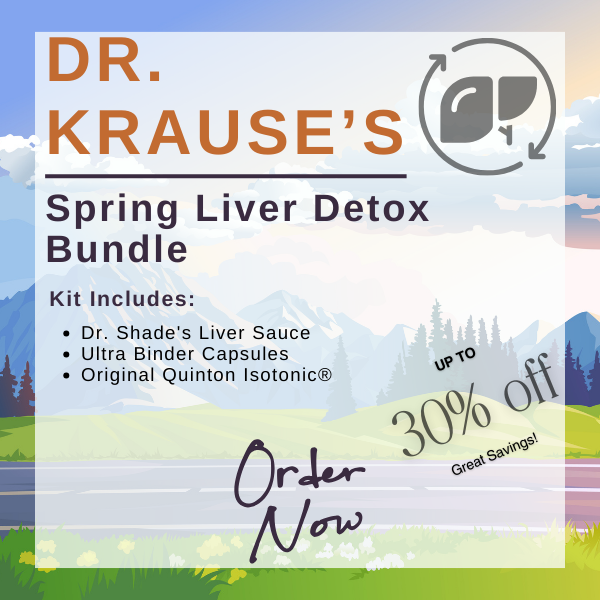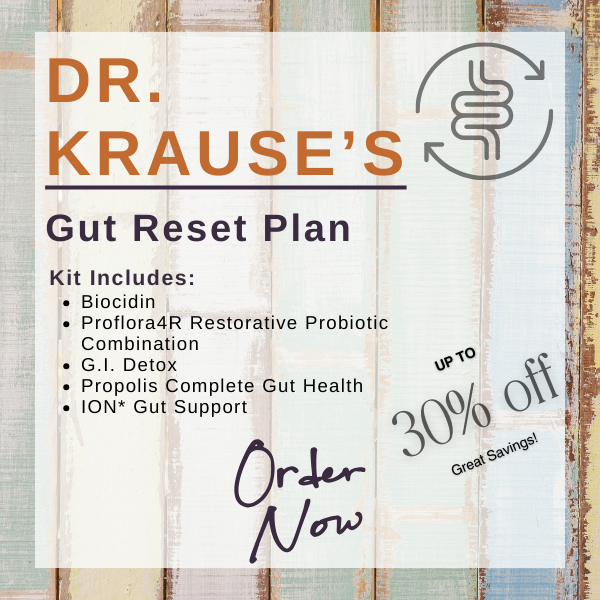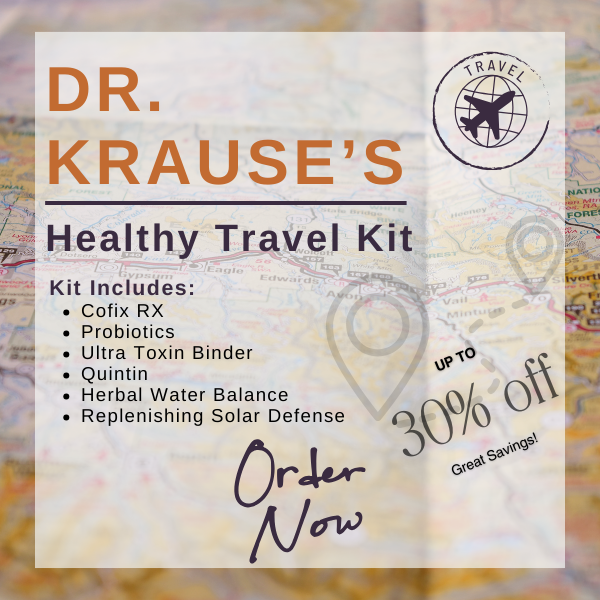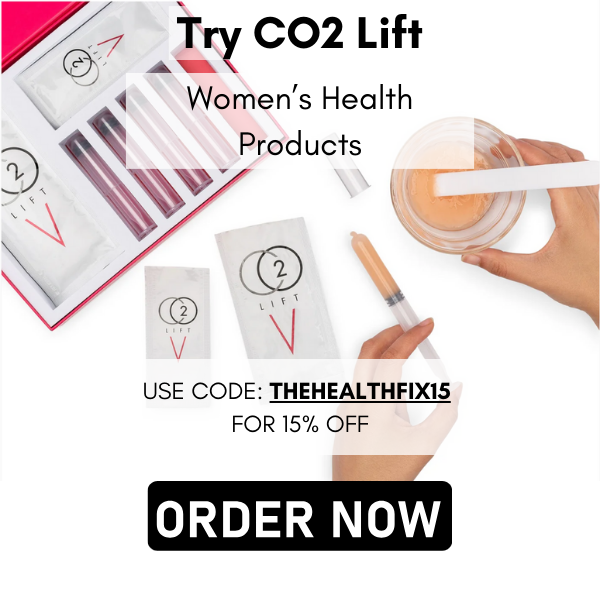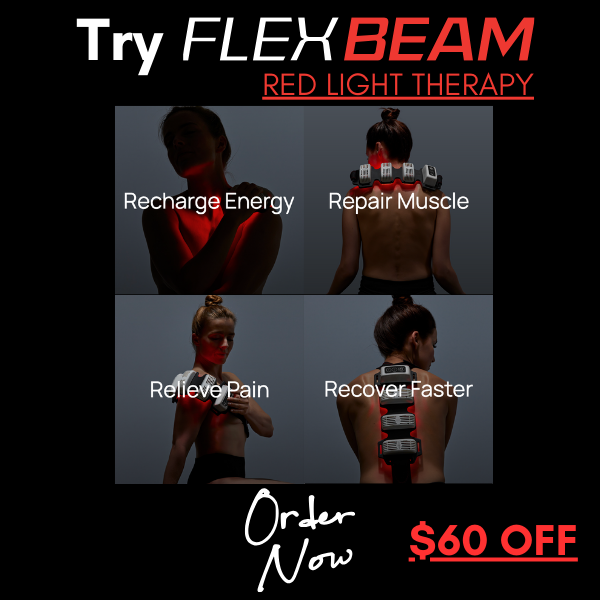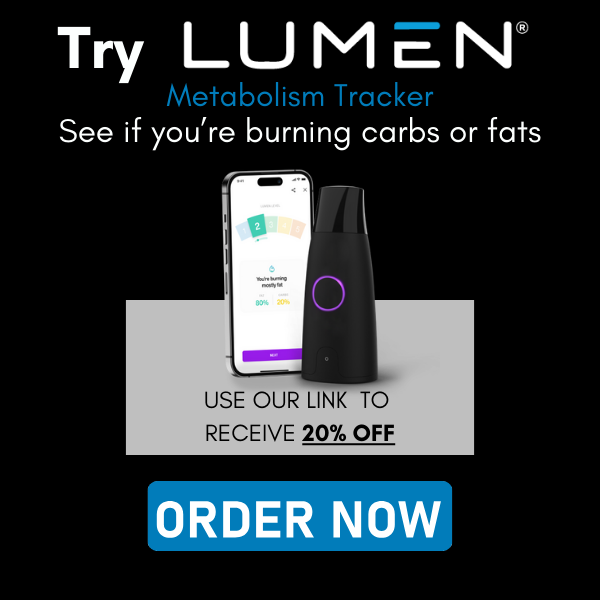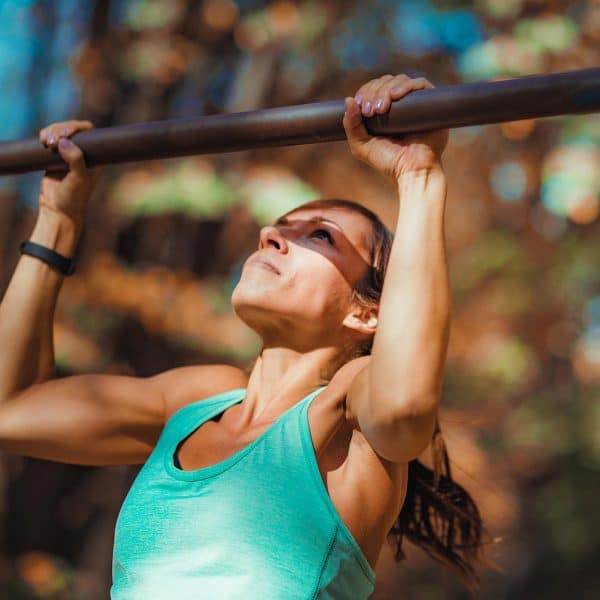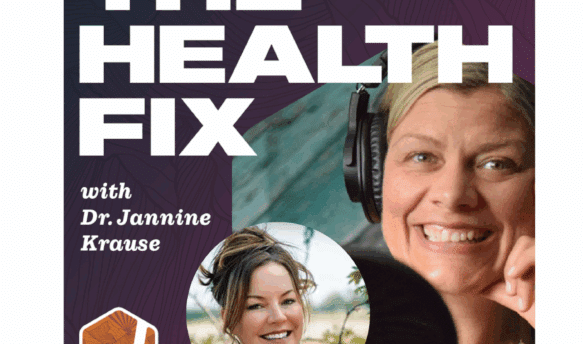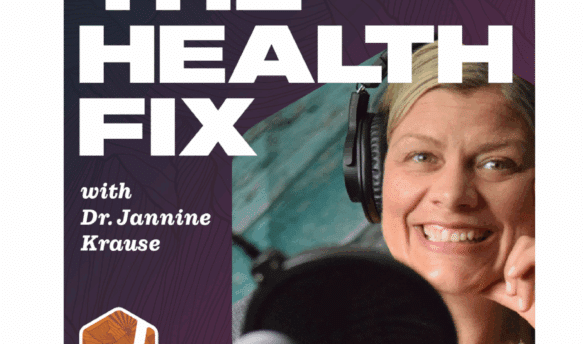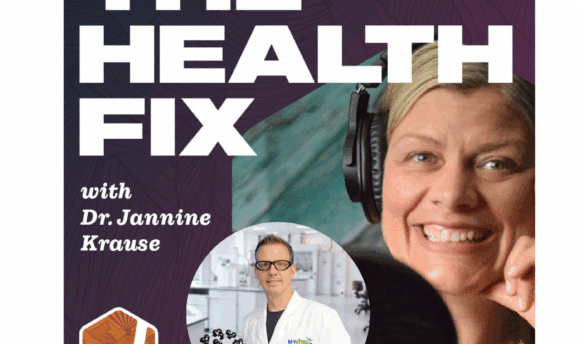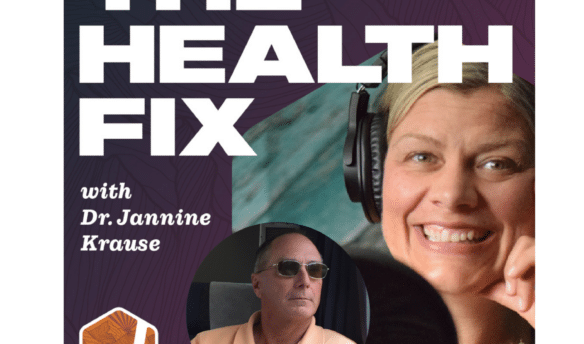Got aches and pains that are starting to get in the way of your physical activity? Looking to boost your cellular repair and energy making capabilities? Want to have something around the house to help you prevent a little injury from becoming a big deal? Bjorn Ekeberg is the co-founder of Recharge Health the parent company of FlexBeam. Bjorn and his team are on a mission to remove barriers to the use of red-light therapy and they’ve created an affordable and portable red and infrared light option, the FlexBeam. In this episode of The Health Fix Podcast, Dr. Jannine Krause interviews Bjorn Ekeberg on the benefits of infrared and red light therapy for sports and injury recovery to aches and pains and digestive system function.
Dr. Krause’s Protocols
Instructions Included
Traveling soon? Looking to detox or reset your gut? Try one of Dr. Krause’s Fullscript plans.
What You’ll Learn In This Episode:
- How near infrared light stimulates the mitochondria of your cells to make energy and repair
- Why you don’t need to use the FlexBeam over 20 minutes a day
- The benefit of putting the Flex Beam on your abdomen
- How the 3 different light angles of the flex beam have the potential to converge on one point for deep targeted repair
- The difference between red light, far infrared and near infrared
- How FlexBeam is being used in cats, dogs and horses
- Using the FlexBeam at bedtime to enhance sleep
Resources From The Show:
- Click HERE to learn more about red light therapy & get $60 OFF.
- FlexBeam – https://recharge.health/
- @theflexbeam on Instagram and Facebook
- @rechargehealth for Youtube
Our Partners
Podcast Transcript
JANNINE: [Intro] Welcome to the Health Fix Podcast, where health junkies get their weekly
fix of tips, tools and techniques to have limitless energy, sharp minds and fit
physiques for life.
Hey health junkies, on this episode of the Health Fix Podcast, I’m interviewing
Bjorn Ekeberg, and we’re going to be talking about the FlexBeam, the wearable
infrared therapy device that optimizes your body’s ability to recover faster.
faster. And it’s even been quoted as the new favorite recovery device by Martin Odegaard.
He’s the captain of the Arsenal FC. If you are a fan of football, he is a big deal. Now,
cool part about this. And of course, we’re going to talk about it in the podcast here is that
the technology that the flex meme has is portable. So if you’re familiar with red light therapy,
you know, you got to plug it in usually to something and you’ve got either a pad or you’ve got a
a panel, and it doesn’t travel so well. But this one, you can move around outdoors with
it. You can, you don’t have to be plugged in anything. So cool. So if you’ve heard any
of my podcasts before, you know that I’m a big fan of red light therapy, I even have
some published articles on it. And it is one of my favorite things for helping with recovering.
So nevertheless, this is going to be a great podcast. If you’ve never heard of red light
therapy. You don’t know necessarily how it works. Bjorn and I am going to go into it in depth.
So, let’s introduce you to Bjorn Ekeberg and the FlexBeam. Hey, health junkies. I am Bjorn Ekeberg
on and we’re going to be talking about FlexBeam. We’re going to be talking about his product from
Recharge Health. And we’re going to be talking about red light therapy, which is one of my most
favorite things. I have a lot of favorite things, but this one’s probably one of my top five in
in terms of health, wellness, and recovery.
So, Bjorn, welcome to the Health Fix Podcast.
BJORN: I’m excited to be here.
JANNINE: So, how did you get in to recharge health?
And how did you get into working with red light therapy?
Give us your story.
What’s your background here?
BJORN: I mean, it’s sort of a circuitous
and serendipitous route, I suppose,
very briefly distilled.
I have sort of a long history living in North America
doing higher university degrees,
pursuing philosophy of science actually,
and then a creative stint in the film and TV industry.
One day I was approached by an old friend of mine
who had another friend that I knew who were basically there.
Expertise was in creating hardware and electronics devices.
They made solar cell lamps for the European market
based in Asia.
And they had come across some research
that really intrigued them.
Some of it was NASA research and PubMed papers
on something that was called photobiomodulation, which
is now later understood as red light therapy.
Like it’s an umbrella term for light actually impacting
your physiology.
And they were sort of intrigued by this.
And they showed it to me.
I had never heard of any such thing before.
So I was a little bit puzzled.
And the unique position that we were in
with two of my co-founders,
plus a medical doctor, Dr. Zudia Frost,
who also joined the team early,
who’d worked with this technology before
and knew about it, was that we were in a position
to kind of make a device on our own,
not having to rely on an external factory or anything.
We had the resources we can create our own product.
And when I first learned about some of the benefits
from this technology, and you’ve used it a lot, Jannine,
So you know quite a bit about how powerful it can be
if you have the right application
and you have the right dosage and so on.
It can do wonders for your health,
but I was just baffled by why we haven’t heard about this
before and what I ended up concluding
from when I was first introduced to this is that
nobody has really made it super accessible
and easy to use yet.
You can, if you’re really gung-ho about it,
you can rebuild, you remodel your basement
and put a wall panels or you can do all the things
and you can get the technology and get the actual light
that stimulates your cells and all the stuff
we will talk about how it works.
But you can’t really find on the market
at the time you couldn’t find something that was portable,
that was still very powerful and just super easy to use
and use whenever you want it.
So we decided to create the world’s first wearable form
red light therapy or infrared light therapy in the form of flex beam is our first invention.
And my role was in sort of taking it to market first on crowdfunding and trying to find an
audience for this kind of product. And as it turned out, it is becoming quite popular and I
think we’ve hit on something that is quite unique in the marketplace and still while we’re still
very small, and we depend on getting the word out through, I mean, people who
know about this technology like you, we are aiming to take this to a wider market and make it more
accessible for a mass market.
JANNINE: Absolutely. I mean, huge. That’s why when I saw the FlexBeam, I was like,
oh, this is neat. You’re not attached to a cord. You are able to take it around. And this was one
of the things that a lot of my athletes, but also my clients in my office were like, yeah,
it’s really nice, but I can only stay in one place with it. And that’s a problem. And then
then it turned into we had the panels and they could work out in front of the panels or ride the
bike in front of the panel or do things and I still do that to the stay I laughed when you said you
have to remodel your basement or room because I’m going yep that’s kind of what we did with
with my area and and it’s great but when you’re traveling then what or when you’ve got something
that you’re trying to rehab and you’re in the field trying to rehab meaning like maybe you
play a sport, maybe you’re weightlifting, whatever it may be, then what do you do? And I feel like
that’s when it had the most ability, because now we’re getting that beam, that light there to where
it needs to be, helping with circulation and healing in stem cells, when the person is actually
active. So this brings me, of course, to your, your, one of your spokes, folks, Martin Odegaard.
Tell us a little bit about how you approached him, what, what he started using it. What’s the story
behind him.
BJORN: We have a few superstars in sports that I got in contact with last year that we got
to trial the product. Martin Odegaard is one of them. He’s the captain of Arsenal for those who
follow soccer or football European football. It’s the leading club and Premier League which is the
biggest football league in the world and he’s the captain of that team. He was nominated for the
the Golden Ball. He’s one of the top 30 players in the world in football. And when I met with him
and got him to try it, he had already tried the technology before. Like you, he had tried panels
and he’d come across it because he had heard about and understood the potential for improved
recovery. And so for him, the pitch was actually much quicker than it was for some of the other
athletes that we worked with, because Martin just immediately, he did exactly like you,
Jannine, like he saw it and he’s like, “Oh, okay, cool. I don’t have to stand in front of a panel,
I can take it with me.” And he can use it and the targeted effect. And for your listeners,
I would just describe it generally. This is like a belt with pods and it would,
broadly speaking, it would fit around your waist or over your shoulder. It’s bendable,
it’s super flexible, so you can put it anywhere on your body and you can attach it to your body.
wherever it hurts. And that’s our approach to sort of there’s it’s twofold with this device.
One is the ease of use so you don’t have to stay in front of a panel so you can literally
like put it on your back if you’re lower back is the issue when you can cook or you can drive
a car or whatever so that it’s sort of time saving in that sense or super easy to use.
And for us this was important because we realized that what the what is the best red light therapy
device. Well, the best device is the one that you use the most, because to get the benefit from
this technology, you need to use it more than just one time. You can have some results already
from one or two or three uses, but it’s the consistent recurring use that will really get you a lot
of benefits and results. And what happens when you stand in front of a panel is very often,
as what we see, it’s fun for maybe the first week and you’re all going home and disciplined,
and after a while, it just becomes a chore. So we wanted to design something that was so easy
that you know you have no excuse for not using it basically and you can integrate into the day
and then have a concentrated enough dose that in 10 minutes it’s usually enough it’s like 10
maybe 20 if you have something extraordinary but you don’t have to take a lot of time it’s
like a concentrated dose so that was one one aspect of it that we’re really intrigued Mark
because he has a as a football player he has knee issues hit issues like it’s in targeted areas
Right, so for him to be able to wrap it around wherever he had a particular need,
that was just a much easier sell for him to use on a daily basis.
But the second part of this has to do with power and the power output and actually getting
sufficient dosage of light. You will probably know from having researched a lot of devices that
are out there, there’s a lot of things out on the market that are various lamps and things
so you can get for relatively cheap, what they will mostly have in common,
not all that some of the panels are quite powerful, but a lot of the cheaper lamps,
they don’t have a lot of output, like you get the light frequency you want,
but you do not actually get the kind of power output you need to really stimulate yourself,
right, to really penetrate through the skin and to stimulate.
And so that was one of the key things we wanted to do with the targeted device is to make it
powerful enough so your dosage is very, very strong and consistent.
And one of the things you, that’s important, I don’t know if you realize this, Jinim,
when you use a panel, but the lights you get from a panel, if you’re only three, four,
five inches away from the panel, you’re already losing 80, 90% of the power.
So if you really want to work on a certain area or make sure you get a certain dosage
of infrared light that you want, you really have to take, put it very, very close to the skin.
And so that was what we wanted to design, not just something that was portable, but also something
that’s bang on the skin that doesn’t lose anything of like, there’s no light lost in the travel from
the device and into your skin, basically. And this, this makes Flexbeam, I am, I’m quite confident
to say it makes it more effective than other red light therapy devices for treating anything,
because you you’re in the process and you like all the energy you you have from the lights go
straight through your skin into where it’s needed. So those are the two things the power and the
portability that we wanted to wanted to create with flexing.
JANNINE: It’s it’s incredibly important because
yeah so at the beginning with with panels we were kind of being sold on you can be a little
bit away from it and then there was also the concept of you might get burned if you were right close
to it. So of course we’re going to talk about that here in a second with the flux being being
right on the body because over time I learned that yes I needed to have these things up close
to my skin which of course now I’ve kind of morphed into different panels that I have
within my office that are going right on to the skin flexible versus my
hang from the ceiling kind of guys that are now more a novelty I would say than anything
at this stage of the game but still I kind of believe a little is going to get something.
So let’s talk a little bit about one of the big things that folks will always say like can’t it
burn you, can’t exposure of too long of a time frame cause trouble, give us a scoop on how you
countered certain things with the flex beam and things of that nature.
BJORN: Yeah well we encase the
the lights on the Flex Beam.
So there is a casing or lens in front
and the lights are receded a little bit from the surface.
We also added fans around it to cool it down, right?
And this is an important feature you don’t see
in any panels or any other kind of devices.
They can get really hot and the reason they can get hot
and then burn your skin is not the lights themselves
but that the device itself or like, you know,
the unit you are using is overheating
because the lights are actually quite powerful.
If you’re gonna have an effect,
you need powerful lights.
So that was one of the design principles for us
and our inventor, Adion Heder,
who came across this NASA research,
is like, was just dead set on creating something
that was encased and had fans.
So our device is the belt,
it’s got a little bit of extra bulkiness on the light pods,
it’s because we have fans that cool it down,
so that you don’t get that sort of hot effect from using it.
It’s warming on your skin,
but it doesn’t, uh, it doesn’t create heat.
JANNINE: Nice.
Nice.
BJORN: So the only contrary to that indication we have regarding burning is if you have a
very fresh tattoo with black ink, you should be probably, you should be careful.
It won’t burn you right away, but we’ve had some really, let’s say some really
gung ho muscle beefy guys who go to the gym and they love the effect of this,
that it has for their performance.
And what often happens when you get excited about something,
you do it three, four, five times more
than you really need to.
So we had a few cases, and therefore,
we put in some contraindications, like user manual as well.
People would use it for one hour on like freshly black ink.
That did not look so good for the skin after.
But I have to stress that that is like overuse,
and it’s a very specific condition.
Otherwise, there is no burning effect or any harmful effects
from using, I mean, red light therapy in general
is very, very safe.
JANNINE: Yes, yes, that’s how I have found it to be.
Now the ink in the tattoos,
this is a different story.
I haven’t heard this before.
So this is good info because you do wonder,
you know, with that kind of thing
and overuse what could happen.
Now, what is the, what is the typical recommended usage
of the FlexBeam, you know, how much a day,
how many minutes per session, what do you guys recommend?
BJORN: So we set up an automatic program.
So it basically you just hit whatever program,
one of three that is based on how deep you want to treat.
So there’s more infrared in the strongest program.
So it penetrates more deeply if you have deep tissue issues,
but all programs are in 10 minutes.
So it turns itself off.
We found on average from all of our testing
that a 10 minute dose is usually enough.
Some people like to do it twice.
sort of analogous to if you take a supplement,
one to two capsules, like one to two sessions.
In a day is usually enough.
Now we have some specific protocols
for specific conditions that we have on our website
and that our doctor on the team has developed.
A lot of protocols for different kinds of uses.
So if you have multiple areas you want to reach
and you have a complex kind of situation
like an acute injury or something,
You may want to consider doing it more frequently
in the beginning twice a day times.
For a general health regime,
if you want to boost your gut health
or just get a general sort of
aim some light into that shoulder
that has been aching for a while,
one to two sessions per day is plenty.
That’s enough and you get results after a few days
of using that extensively.
It doesn’t need to be more.
and this is really crucial, Jannine, like the overuse
will not be damaging from all the researchers telling us
and all the use cases we see.
It’s not dangerous to use it too much,
but if you use it too much,
you are not gonna get an effect.
The body adapts very quickly.
That’s why there’s a window of dose
such as an ideal or an optimal dose
that we’ve tried to create for the device.
So you don’t need to use it more than 10 or 20 minutes.
We can all get kind of over eager when something is working.
And we see this a lot when people are testing it out.
And then when they get that response to something,
they had to pull muscle or something.
And it’s like, damn, I can actually
feel the difference in one day.
And then they become super excited.
And they use it an hour, two hours every day.
What happens with that is a little bit like you go to the gym
and you have a hard workout.
And then you get so excited by that workout.
And you go back and you do three more times
before you sleep, you’re not gonna get three times stronger.
You’re just gonna wear out your muscles
and you’re gonna wear out the stress response
at the cellular level so that the net effect
is actually less adaptation or like less response
in your body.
So there is an optimal window there.
JANNINE: That’s great that you explain that.
I think a lot of people, yes, there is that concept, right?
If a little’s good, then much more is gonna be even better.
And at this point, of course, it’s one of those things
you know, your stem cells will time out, your, you know, your system will time out on the ability
of healing that it can only do within a certain timeframe. So one of the things I think that I
would love to dive a little bit into if it all possible is like you had mentioned the different
protocols and the depth because this is like the biggest argument that I get from folks online
anytime I post something on red light therapy is, is it going to work? Because how does it get
pasta skin and how far can it actually penetrate? And you had mentioned the gut and that’s one of
the ones that a lot of folks will kind of argue with me that there’s no way it’s going to get to
the digestive system. And I’m like, well, let’s talk wavelengths here a little bit and how you
explain it to folks in terms of the different depths.
BJORN: Yeah, because now we’re getting into
the difference between visible and invisible light, right? So we have
energy that comes from the sun, which is what engulfs us at all times. We get some
reprieve for him in nighttime, but literally we’re living close to a cosmic fireball of energy
that sends energy like to us all the time in a whole broad spectrum, the electromagnetic spectrum.
There’s a very tiny part of that spectrum is called visible light. It runs from blue to red
light through green. It’s a very narrow bandwidth. That’s what we can see with our eyes. But most
of the energy that comes from the sun is in either to the left side on the spectrum off of visible
light is in the ultraviolet range, microwaves and so on. They’re very short wavelengths. They’re
too short for the eyes to see. And there’s a large section of the electromagnetic spectrum
called the infrared spectrum that is invisible light. You can feel it as heat typically. So if you
ever you know watch the sunset and you have that glowing feeling when you watch that beautiful red
color the glow you can have on that you can feel on your skin that warmth that is infrared the
color you see is red but the infrared is a huge part of that spectrum and it’s the same principle
for i mean the lights that are in flex beam and in a lot of panels it’s a combination of red
which is visible light and then near infrared, which is invisible. And the importance here in
terms of wavelength is that the infrared wavelengths are longer. They are longer than the eye can
then pick up as visible. But the longer wavelengths means that it has the ability to penetrate the
skin. So some of your listeners may be familiar with the concept of infrared sauna, which is
is becoming popular in some circles.
That is a far infrared.
That’s a different way we use in FlexBeam
and that it’s a red light therapy devices.
It is an even longer wavelength,
but that has the effect that it penetrates so deeply in
that it actually induces sweat in people.
So our infrared has that capacity to go all the way through
and then generate kind of heat and energy
at the core of the body.
Now near infrared, which we use,
which is the most sort of,
if you’re ever gonna talk about a magic kind of range
on the electromagnetic spectrum, the near infrared,
this is between 800 and 850 nanometers.
It is like any light in this range with sufficient output
is shown to stimulate at the cellular level.
So it stimulates the mitochondria in your cells.
And the mitochondria are the energy generators in your cells.
So literally by being exposed to near infrared lights,
you are stimulating the cells to produce more energy
to do what they do.
And what do the cells usually do?
They repair themselves, right?
They are engaged in healing and repair all the time.
And when you give them more energy or stimulate them
with this kind of energy, they work faster and better.
They basically get more food to do what they do best.
And that’s kind of, that’s the beauty of near-infrared
treatment that you can’t quite see with your naked eye,
but it can get under your skin.
We’re talking two to four inches in with our power setting,
depending on what’s in the way.
So if there’s a huge bone or something in between,
it can’t penetrate that far.
But for deep tissue, for example, for a lower back,
you can get three, four inches into the body.
For a joint like a knee or an elbow,
we designed Flexbeam to have the lights
from three different angles, so you can bend it,
so you basically can get three different light pods
are all converting on the same point.
So you can literally get in and treat inside of a meniscus
or similar kind of tool like area.
This is part of why we designed it in the sort of belt-like
shape is that you can direct all of the light
in the same direction if it’s needed.
JANNINE: That’s cool.
That’s something I hadn’t thought about
just looking at the device,
but now that you mention it and the way it’s set up,
yeah, we can direct the light in,
oh, that’s super cool.
So folks, what he’s getting at here is,
say you have the kid mention a meniscus issue
or say there’s an elbow issue and it’s deep in there
and nothing seems to be, you know, touching it.
Now we’ve got three ways to kind of and forgive me,
laser beam is not exactly what’s happening here.
I just wanna make sure that very clear,
but I’m gonna use the term to describe
how those light beams are getting straight to the point.
That’s really cool.
And for a doc like me, I’m like, okay,
I’m thinking the hip,
like kind of what you’re talking with Martin
and how targeting the hip.
This is some really cool stuff,
especially with four inches.
I mean, that’s a decent amount of distance we can get in
to work at some of those little ligaments
that can really cause some trouble,
whether it’s hip or SI joints or something of that nature too.
Cool.
Okay.
BJORN: That’s why we see a lot of positive effects
with injury, not just on the preventative side
that you can do for generally to boost your health,
but injury recovery because you can get more deep repair
this way by the way that the device is designed.
JANNINE: That’s neat.
I’m thinking of very, like various patients
and I’m going like, “Hmm, I’ve got lots of ideas now.”
Now, for those of you who are listening,
I apologize, I’m gonna have,
I’m gonna have Bjorn show the device
to kind of talk through it.
And don’t worry, you can catch it.
We’ll get the clip up on Instagram
and I’ll get the clip up on YouTube
so you can actually see what things are looking like.
So let’s talk it through.
So we’ve got, it’s like a band, it’s a belt
and it’s flexible, hence the term flex beam.
And we’ve got pods there on each end
’cause that’s how he was describing the fans.
So I’m gonna let you take over, Bjorn,
’cause I’m talking–
BJORN: Yeah, it’s got four pods, three of them are light pods
and I’m now gonna turn it on
so you can see what the lights are gonna look like
when you turn them on.
There’s three different settings.
Again, they have to do with depth.
So there’s one setting that’s more for skin than surface.
So red light that we haven’t talked much about
is very powerful for skin for collagen,
production, elastin, et cetera.
If you’ve heard about red light therapy
in other circumstances than injuries and so on,
it’s usually like cosmetics and beauty applications.
There’s a lot of popularity around them.
These are very low output devices.
You don’t need a lot of power to get effects on your face.
But you do need quite a lot to repair in the body.
So we’ve added infrared, which is the most powerful setting
for repair, and settings 2 and 3 then go deeper, basically.
The more infrared you have, the deeper in you can go and repair.
So now I turn it on the middle setting,
and you will see the lights are a combination of red,
and the infrared you can’t quite see,
which has just got a little bit of a dark hue to it.
JANNINE: Gotcha, there we go.
BJORN: And the lights are angled in different directions.
So even though there are three pods,
they spread out in such a way that they give an even,
they give an even distribution of light
across the whole surface wherever you place it.
So if you use it on your stomach, for example,
which is a very popular wellness application,
You, like the whole surface area of these three pods combined,
you are now shining light onto that,
like the entire gut region, if you hold it vertically.
For example.
JANNINE: Yeah, yeah, I can see that, okay, okay.
BJORN: So you can hold it sort of vertically.
A lot of people, if they’re meditating,
they love actually putting it on their stomach
while meditating.
So you get sort of positive boost to your gut
while you are focusing your energy on it.
That is one, like popular as a general wellness application
that you can use, even if you’re not in pain
or don’t have any aches or anything,
you have a lot of light receptors in the stomach.
Like we all do, a lot of them,
mytocondria actually sit in the stomach lining and so on.
So it is often what we recommend
for people who want to feel the effect.
Like unsure if it’s going to have an effect for them.
It’s like put it on your stomach for a session or two
and see how that feels after.
And maybe the next day,
if you notice any difference in digestion and so on.
And in most cases, that definitely yield some sort of effect
that you can use the power.
JANNINE: I can see a combination kind of thing.
Someone could do that along with some changing up the diet,
things of that nature to help improve things as a whole,
maybe even a post-holiday detox of sorts for certain folks.
BJORN: I mean, I know from myself and people I know who use it a lot on the stomach is that it can be very comforting and it makes also sure that things are moving like for constipation and these kinds of things like it definitely helps to sort of for the whole process to kind of to speed up and get more energy to do.
You know what the what the gut is supposed to be doing.
JANNINE: it makes sense. Wow. I mean, I, I’m thinking so many other applications too, just, just for
cell healing, a lot of folks have thyroid issues. I would be thinking, you know, neck, I’d be thinking
different things. Now, one of the things I get asked a lot, Bjorn is, is if your eyes come in
contact with it, will it make you blind? And, and I, you know, obviously, I’m always like,
well, don’t stare into the thing and put it right over your eyes. What is it? What is it?
you’re what’s the your guys’s blanket statement on that just so folks get a little background.
BJORN: Yeah it’s
exactly as you say avoid staring into the lights um the reason why it can be harmful if you stare
into the lights for a long time uh so it’s not like what we’re talking about here is not a you
catch a glimpse of the lights it won’t have an effect it would be the same as if you look at the
sun if you like stare at the sun for a second you may get a little blink in your eye but it’s not
going to damage your eyes, but if you stare at the sun for a minute, that’s probably something
you were advised as a kid to not do. For the same reasons, like in this device, what happens
with infrared light is because it’s invisible, your eyes don’t naturally blink. So we actually
put in some red light into the infrared setting to help the eye in case you were to look at it,
like to get a blinking response. What can be dangerous of staring into infrared light is,
literally you don’t have the normal blink response which is a protective response to your eyes.
So we do give away like there’s goggles inside of the box in case you want to use it over your
face. Generally speaking we just say avoid staring into the lights but it’s not dangerous unless
you were to do that. It’s a little bit like you know an hour on the tattooed body kind of thing,
it’s like overuse and so on. It’s only if you do it extremely that it could be dangerous.
JANNINE: That’s something I hadn’t really thought about in terms of the blink response. That’s
something I don’t think anyone’s talked about before. That’s really cool to know that that’s
part of why we’ve got that.
BJORN: There is a specialized use and there’s a lot of research indicating
that red light specifically can be helpful for the cornea and for certain eye conditions.
But this is something we we just generally advise then you need to speak to a medical practitioner
about the you know to use it don’t self-experiment with this and look into the light and and so on
because these more delicate parts of your body they need more specific and often lower doses than
you know, your muscles or you are like, you’re torso, so to speak, or your legs do.
JANNINE: It makes sense.
BJORN: Yeah.
So in terms of the eye, it’s not to worry about, but general, general caution,
that these are powerful lights, you know, so, so I have to keep in mind when you’re using it.
JANNINE: Now, another thing I know I’m going to get is what about with pets? Can you use the flex beam with
with your pet, and I would love to hear your answer there.
BJORN: Absolutely, absolutely, it’s one of the favorite applications
we have for pet owners who use it on their pets.
So if you have a very long haired, extremely furry pet,
the light’s gonna have a harder time penetrating
than if you have someone like short haired.
We’ve actually developed, we haven’t started
putting it into production and selling it,
but we have an attachment in the pipeline
that would help to get through the fur
for when we focus more on this,
but like we sell it to humans and they are the ones
who usually embrace this, but for cats and dogs
and horses, specifically horses that have targeted issues,
we have a lot of case studies on this being
like giving positive results.
It works on animals as well as it does with humans.
Dosech may vary, but we found that this is still
a 10-minute section is still within the same zone.
I have myself, I have a cat that’s doing this at night that’s nice and warming, but he often
walks away after six, seven minutes, he’s had enough, and usually, I think that they’re
more intuitive and they kind of know when it’s, when it’s the right call to go.
JANNINE: Yeah.
BJORN: [indaudible]
Yes.
JANNINE: Yeah.
They’re impressive creatures.
It’s impressive.
We can learn a lot from them, but thanks for, thanks for sharing that because I know that
people are going to ask me like, can I put it on my dog, my cat?
I mean, horse, I didn’t even think about horses,
but it makes sense, right?
So, oh, man.
BJORN: They often have sort of hip kind of issues
or like very targeted issues.
Of course, the flex beam is very small on a horse,
but it can be super helpful in a concentrated area.
Right, where it’s with a cat and a small dog,
you can, you kind of envelop the animal in the flex beam
and they will, most of them will respond
very positively to the warmth and stay put.
So they often come back, it’s usually a sign they like it.
JANNINE: Ah, nice, I think that’s great.
I can’t wait to hear how you guys do with your device
to the counter of the fur.
That’ll be fun to see how that goes.
– Yeah, it’s just a simple mechanism
to kind of allow the light to penetrate more deeply
so you can get further in.
But for most regular fur, short fur,
there’s something, it’s not a major issue.
So the light would still come through.
JANNINE: Nice.
BJORN: One, if I can mention one application, we didn’t design FlexBeam for– like we designed this for,
you know, to fit the body in the most effective way with the most power output and ease of use.
So like an elbow or like on the stomach or shoulder or around the leg for muscle repair
and for pain reduction or pain alleviation. And then early on, we started getting case studies
from people who tried it for sleep
and who tried using it at night,
either over their chest or on their stomach
as a soothing, comforting ritual before they went to bed.
And they started sending us their sleep metrics
because they would have tracking devices
like an Ora ring or like a Garmin watch
or something in their sleep and showing they had a deep sleep.
And so we started accumulating some of this data
and started testing it out more.
It is now a feature that we were considering advertising it
more because sleep is a very important issue
and also for recovery.
But it’s a very, very popular kind of protocol to follow.
A lot of people report, and myself included,
that it’s using it 10 minutes at night
will help support a deeper and better sleep, which then
helps the recovery process overall.
As I was an unintended kind of feature of this,
that we are building drawing more on the science.
So we get from the users and try to build also
for the next device, something that’s even more tailored
for you to have in bed, for example.
JANNINE: That’s cool.
Yeah, you wouldn’t think of it ’cause you,
people would associate light with waking up
and morning and things of that nature,
but I can see how it can induce the recovery state,
as well.
Do you kind of keep your eyes from it
so you don’t get the light stimulation
or have you noticed independent?
it’s independent for you.
BJORN: Will you put the lights on an area of your body?
It’s typically the chest.
It can also work on the lower back or the gut.
So the lights are kind of facing the body
and the energy goes in there.
So you don’t really seeing it very much.
You know, red and near infrared is on that part of the spectrum.
That is the furthest away from blue light
or anything that’s disruptive to the melatonin
or the circadian rhythm and the melatonin production.
And so it has the same kind of wavelengths
that some of these applications have
that reduce the amount of blue light in screen
and stuff before bed.
So in order to get any kind of disruptive light effect
from it, again, you would have to stare into it.
It’s not a such a bright light
because it’s on the red side of the spectrum.
So it works in the bedroom as a,
if anything, it’s a romantic kind of lighting vibe
because you get a really red kind of glare.
So no, we haven’t seen any effect
that it has a negative effect on the circadian rhythm,
quite the opposite.
And some people use it early in the morning
to get that extra dose of morning lights,
which then helps to regulate your circadian rhythm as well.
So it can be used at a morning or evening or for sleep.
JANNINE: Nice.
Yeah, I didn’t think about that, but–
-BJORN: Yeah.
JANNINE: That’s fun, that’s fun.
Yeah, I, you know, when you think about light,
you’re like just light in the eyes in general,
but yes, the red light is more of the evening,
you know, what your blue light’s more of the issue.
So that makes sense and that’s great
’cause I think a lot of people will wonder about that question,
you know, just that in general.
So there you go.
All right, what other non-traditional uses do you have?
What else have you heard?
I’m super curious now of like,
what other things have you heard from folks?
BJORN: I mean, we get sort of user feedback
and review levels daily.
a lot of them around the same issues.
Last week, we got from a lady who loved using it on her,
like setting one, the red light on her hair to dry her hair.
And she claims that she then gets more volume in her hair somehow.
This was new to us.
We all had a laugh, because this is not what it was designed for,
and it’s not what I would recommend.
But people are creative, and you can use it
for lots of different potential issues
you might have with the body.
So as long as you use it within the simple safety guidelines
that are now outlined, it started as a biohacking device
or the favorite device of people who want to try out
and experiment a bit themselves.
It is safe to do so and I think you could find
your own personal use of that if there’s not
specific body parts that, um, that kind of stands out as your sort or your sticking point,
which is usually where people put it.
JANNINE: Yeah, not thinking like rotating, you know, spots,
things of that nature. If you don’t have something that’s like currently pressing, you could,
you can move it around and see how it goes to such cool stuff, such cool stuff. And so
we’ve got Martin, you know, kind of, let’s put it this way, taught, you know, talking
up your product using your product, who are your other athletes, just so folks can kind
of hear and maybe follow and see what they have to say, just to gain a little more background
for them?
BJORN: Yeah.
For those who follow tennis, we have an amazing tennis player called Casper Ruud, whose last
year was number three in the world.
I think this year, the end of top 10, but he’s played Grand Slam final, and he’s used
it for a year now, so he was the first to– who signed up to, he invested in our company
after trying the device. And we’ve been partnering with him this year. He uses a daily and as part
of his physiotherapy regime. For us, that was a very good illustration of the very targeted use
for forearm and elbow, like tennis elbow. And for him, he uses a lot for his serving arm.
Tennis at that level is extremely competitive and a lot of repetition. So he was really intrigued
buy something that could help them come back more quickly between matches, you know, the schedule
in professional tennis is grueling. In some of the tournaments, they have to play back-to-back
day after day in some of the tournaments, so they get one rest day after playing, you know,
a three-hour game, so three-hour matches, and so on. So it was very good, and we’re still working
with a lot of physiotherapists in the tennis space that’s been a very popular, like popular
application for FlexBeam and increasingly Golf as well.
We are working now to, I don’t have the names yet,
but like that I can announce,
but working with some Golf profiles.
And we expect that’s a sport that also is sort of
a perfect fit for a device like this,
because you can take it with you on the Golf Course
and it fits like targeted issues like hip injuries
or like that, you know, you have one arm or one shoulder
or something that’s a little bit irksome.
I’ve heard stories from chiropractors in golf
that has claimed that between 60 to 80% of golfers
are injured and they just play through their injuries.
But the injuries there are, there’s a lot.
And a lot of injuries go, say, under the radar
of you don’t seek necessarily medical attention for it,
you just kind of have like some aches and pains that come from being active, that you
wouldn’t think to go to a catheseo therapist, to go to a doctor. And that’s really for us
the key sort of demographic right now for flex beam and who were trying to reach through
Martin Odegaard and Casper Ruud. And these top athletes is not that it’s for athletes
only. This is really for everyone. But is to get the message out to people who generally
we have an active lifestyle, we like to stuff,
but that most people have something that’s set them back
or something that’s blocking them
from doing the run that they love
or do the hike that they used to be able to do.
And identify as necessarily of being sick
or in need of specialized equipment.
They’re just kind of brushing away their aches
and pains or their things.
So that’s really who we have in mind right now, Flex Beams is a core audience, people
who want to improve their health somehow and have something that they can use it for in
their active lifestyle.
JANNINE: Makes perfect sense.
That’s what I was hoping to get to by talking about the athletes because elbow stuff, being
an acupuncturist myself, it’s, elbows are tricky.
And even golfers, elbow stuff, huge.
And you know, most of us have some little thing.
I mean, it seems like once we get over 40,
there’s little things that start to nag us a little bit.
And yeah, we might not necessarily go to the doc
as like, it’s not that bad.
It just happens at certain times, you know, little tweaks.
And so makes perfect, perfect, perfect sense
to look at it as a way to heal, recover,
and keep something little from becoming a big issue
and messing with it–
BJORN: Exactly.
JANNINE: Over time.
BJORN: Yeah. Uh, what do you use it for? Mostly Jannine.
JANNINE: My low back and,
and my SI joint and my hip. Yeah. I was a figure skater as a kid and fell a lot on the ice. And,
um, that’s my big thing. I, I now have ended up with a little bit of pain and tweakiness.
It’s not all the time, but I do it repetitively because it does seem to, to keep me moving.
And then I’m not moving in weird patterns, which I think is a whole nother thing that,
that the red light therapy can be incredibly useful for us,
keeping you out of weird, muscular patterns,
that’ll then lead to something bigger down the road.
BJORN: Yeah, exactly.
I mean, the doctor on our team,
like we co-founded this business with,
who has worked with this technology
for several decades with patients,
her big vision was to create something
that people can use at home,
so they didn’t have to go to the doctor.
And really, the preventative use
is probably the most powerful aspect of red light therapy
or infrared lights that if you can treat something before it
becomes an injury, it has a much greater health application.
Most people are not so proactive in response to something
that has happened.
And so we see most people are buying this device
because they are in pain.
But if you can get into that regular research
and make it into a daily ritual, so to speak,
easy 10 minutes of your day, you can, I think, invest a lot in avoiding complications in the future.
JANNINE: Yeah. And having such a portable device, I mean, that’s the biggest thing that drew me to Flex
Beam. Like, I’m like, whoa, you’re not attached to something, you’re not attached to a plug,
you’re not, you know, I’ve literally rigged it on an extension cord for me to be able to work
in the kitchen with my red light device attached to me. I mean, it’s goofy, but that’s what we do,
right to try to figure these things out. This solves like people tripping, people getting injured
with extension cords. I might have to do it.
BJORN: Yeah, that’s a whole other aspect.
JANNINE: No, it’s huge. It’s huge. So, yeah, I think this is this is great stuff. Now, tell us a little
bit just so folks get the full spectrum because we were showing the device. It’s a is it like
rechargeable? You put it into like a little plug unit. How does it work in terms of getting it
it charged back up and things of that nature,
just so folks have the full idea.
BJORN: Yeah, so it’s a rechargeable device
and the battery typically lasts five to six sessions.
So like 50 to 60 minutes of use,
a little bit depending on which preset,
like which program you use.
And so generally just use it, recharge it after,
you just, it’s a basic plug
and it charges within an hour
or something like this, so it can be recharged
many, many times to put it this way, if you use it a lot.
JANNINE: Okay, okay.
BJORN: Yeah.
JANNINE: Okay, that was what I was wondering about.
I was wondering if there was like a battery pack
or if it was just plugged, so good to know.
BJORN: Yeah, the battery pack is embedded
into the fourth module that doesn’t have lights in it,
so both the controller and the battery is in there,
so it’s super easy to charge,
and we’re also working on like a version two
that will have improved battery
and more integrated in with the other light pods and so on.
Because battery is the one thing that will wear out,
like if you use it a lot.
But we have a five-year warranty on the product
and we stand behind the quality of this as something
you can use for a long time.
JANNINE: Five-year warranty, that’s huge.
That’s huge, folks, take note of that.
‘Cause I don’t think there’s any other company
that I know of now that’s got that long of a warranty
on any of their products.
So good to know, good to know.
Wow, we’ve learned a lot.
I’ve learned a lot about the FlexBeam.
I’m looking forward to trying it out myself
and showing the difference between my extension cords
with my current panel and how it looks for me to cook
or do whatever in my house compared to having
the FlexBeam on.
So stay tuned for that.
Bjorn, give us a scoop on, you know, the website
to find FlexBeam is Recharge Health.
And so give us the scoop on where they can find it.
Is it on, do you have some stuff on Instagram,
social media, give us a scoop, where can we find
everything we can possibly find?
BJORN: Yeah, absolutely.
So our company is called Recharge Health,
short version Recharge, because that was our mission
from the start, we wanna recharge people’s health.
So you find us at recharge.health,
the device is called FlexBeam.
So on Instagram, you find us on the FlexBeam,
app, the FlexBeam, and so you will find it anywhere
you search for that.
We sell in our web shop and deliver directly
to customers next business day shipping.
Everything as you would expect from an e-commerce platform.
And we also have a 60-day money-back guarantee,
so we encourage people to try it for themselves,
because we know that the vast majority of people,
they want to keep it after they use it.
So for us, it’s kind of a no-brainer.
So I encourage you to check it out and give it a trial.
I think we can do a little deal for your listeners
embedded in the show notes here as well
for anyone who would like to try.
And with holidays also coming up soon as we are talking,
it’s also a great gift for a family
or someone you care about.
You can be used by many people and households.
It’s also a favorite thing to use in a home
that you can find multiple uses.
and people may be fighting over it, I’m not sure.
JANNINE: I know in my family there has been fights
over the red light panels, so there’s no doubt,
but I mean, it’s a great way to give the gift of health
at any time, you know, whether it’s someone’s birthday,
or the holidays, it’s a great device,
and I can see how it is incredibly innovative
with the mobility aspect of being able to take it
with you anywhere.
I mean, that’s something that we,
there isn’t anything else out there, so.
BJORN: I’m glad you could see that and appreciate it from your own use of the technology. We are still
sort of in the infancy of people knowing about this kind of technology. We started our company
with the idea and the kind of hairy ambitious goal that one day this will be known to people
as something you just have at home because once you realize how powerful it can be, it’s sort of
a no-brainer you would have one at home to use for yourself. And we want to be like with FlexBeam,
we create the first product and we have more versions to come to create sort of the ultimate
product to reach a wider market. Anyone who want to try this out and
learn about what this technology can do for you, I highly recommend trying it and integrating it
into your daily routine or daily health regimen. Love it. It’s the best way to recharge. I hands
down. So if you’re in, thanks again for coming on folks. We will have the codes and things of that
nature in the podcast notes at doctorjkrausend.com. Great conversation Bjorn. I’m looking forward to
hearing about what you guys got coming on next in the future and we’ll definitely bring you back
on and chat about that as well.
BJORN: I would love to be back. Thank you so much for the conversation
and the opportunity and for also spreading good news about health and what you can do to empower
your own healing.
JANNINE: My pleasure. [Outro] Hey fellow health junkie, thanks for listening to the Health Fix Podcast.
If you enjoy tuning in, please help support me to get the word out about the podcast. Subscribe,
rate and review and just get that word out. Thanks again for listening.

